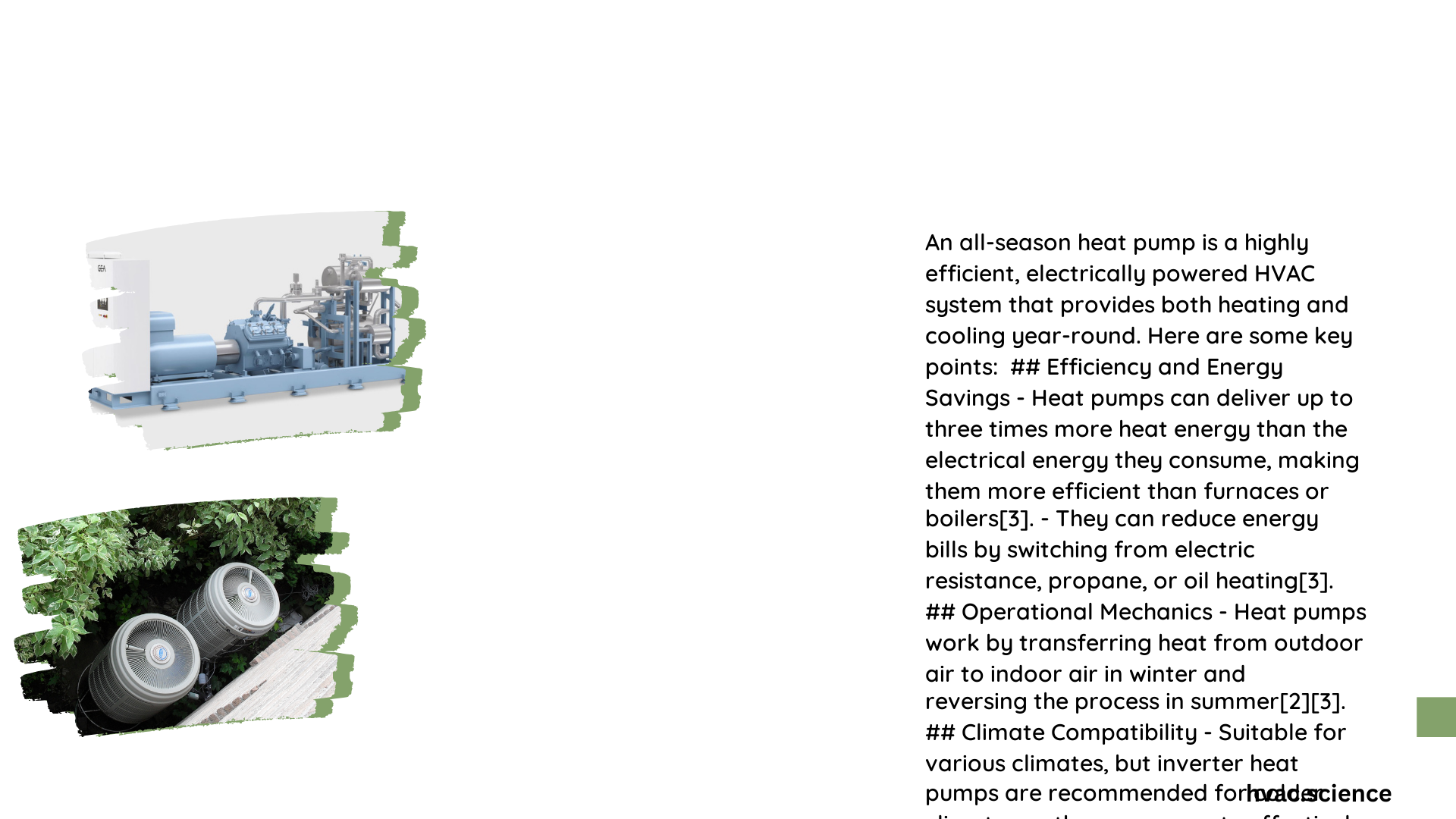An all season heat pump is a versatile HVAC system that provides both heating and cooling for homes throughout the year. These energy-efficient units transfer heat from the outside air to inside during winter and reverse the process in summer. All season heat pumps offer significant energy savings, improved comfort, and reduced carbon footprint compared to traditional heating and cooling systems. This comprehensive guide explores efficiency ratings, installation processes, maintenance requirements, and potential energy savings of all season heat pumps.
What Are the Efficiency Ratings for All Season Heat Pumps?
All season heat pumps are rated using two primary efficiency metrics:
- HSPF (Heating Seasonal Performance Factor): Measures heating efficiency
- SEER (Seasonal Energy Efficiency Ratio): Measures cooling efficiency
HSPF Rating Explained
- HSPF measures the heat output relative to electricity consumed during the heating season
- As of January 1, 2023, minimum HSPF2 requirements:
- Split system heat pumps: 7.5 or higher
- Single-packaged heat pumps: 6.7 or higher
- Higher HSPF ratings indicate greater efficiency
- Example: A heat pump with HSPF 7.7 delivers 2.25 times more heat energy than electricity consumed
SEER Rating Explained
- SEER measures cooling output relative to electricity consumed during the cooling season
- Minimum SEER for split-system air-source heat pumps: 13
- Energy Star models exceed 14.5 SEER
- Higher SEER ratings indicate greater cooling efficiency
- Example: A 16 SEER unit is 38% more efficient than a 10 SEER unit
How Does Climate Impact All Season Heat Pump Efficiency?

The efficiency of all season heat pumps varies depending on the climate:
- Colder Climates: Higher HSPF rating is more important due to longer heating seasons
- Warmer Climates: Higher SEER rating is crucial for longer cooling seasons
What Is the Step-by-Step Installation Process for an All Season Heat Pump?
Installing an all season heat pump requires careful planning and execution. Here’s a step-by-step guide:
- Site Preparation
- Clear and level the installation area
-
Check for obstructions or hazards
-
Unit Placement
- Position outdoor unit (condenser) in a well-ventilated area
-
Install indoor unit (air handler) in a central location
-
Electrical Connections
- Connect wiring between indoor and outdoor units
-
Ensure compliance with local electrical codes
-
Refrigerant Line Installation
-
Connect and insulate refrigerant lines
-
Thermostat Installation
- Install compatible thermostat
-
Program according to heating and cooling needs
-
Testing and Commissioning
- Test system in both heating and cooling modes
- Check for leaks and proper airflow
Installation Time and Challenges
- Average installation time: 4 to 12 hours
- Common challenges:
- Incorrect system sizing
- Improper refrigerant line installation
- Electrical issues
- Insufficient insulation
What Is a Comprehensive Maintenance Checklist for All Season Heat Pumps?
Regular maintenance is crucial for optimal performance of all season heat pumps. Here’s a comprehensive checklist:
| Task | Frequency | Estimated Cost |
|---|---|---|
| Filter Changes | Every 1-3 months | $10-$50 per filter |
| Coil Cleaning | Every 3-6 months | $50-$200 |
| Thermostat Checks | Monthly | $0-$100 |
| Refrigerant Leak Checks | Annually | $100-$300 |
| System Performance Checks | Annually | $100-$300 |
Tools Required for Maintenance
- Filter replacement kits
- Coil cleaning brushes and solution
- Multimeter for electrical checks
- Refrigerant leak detection kit
- Thermostat calibration tools
What Are the Average Energy Savings Percentages for All Season Heat Pumps?
All season heat pumps can provide significant energy savings compared to traditional heating and cooling systems:
- Heating cost savings: 30-50%
- Cooling cost savings: 20-40%
Factors Influencing Energy Savings
- Climate: Efficiency varies based on local weather conditions
- System Sizing: Correct sizing is crucial for optimal energy savings
- Maintenance: Regular upkeep ensures continued efficiency
- Usage Patterns: Thermostat settings and operating modes impact savings
How Do All Season Heat Pumps Compare to Traditional HVAC Systems?
All season heat pumps offer several advantages over traditional heating and cooling systems:
- Energy Efficiency: Can transfer 300% more energy than consumed, compared to 95% efficiency of high-efficiency gas furnaces
- Versatility: Provides both heating and cooling in a single system
- Environmental Impact: Reduced carbon footprint due to higher efficiency
- Cost Savings: Lower operating costs over time, especially in moderate climates
What Are the Key Considerations When Choosing an All Season Heat Pump?
When selecting an all season heat pump, consider the following factors:
- Home Size: Ensure proper sizing for your living space
- Climate: Choose appropriate HSPF and SEER ratings for your region
- Budget: Balance upfront costs with long-term energy savings
- Features: Look for advanced features like variable-speed compressors or smart thermostat compatibility
- Warranty: Compare warranty offerings from different manufacturers
By carefully considering these factors, you can select an all season heat pump that provides optimal comfort and energy savings for your home.
